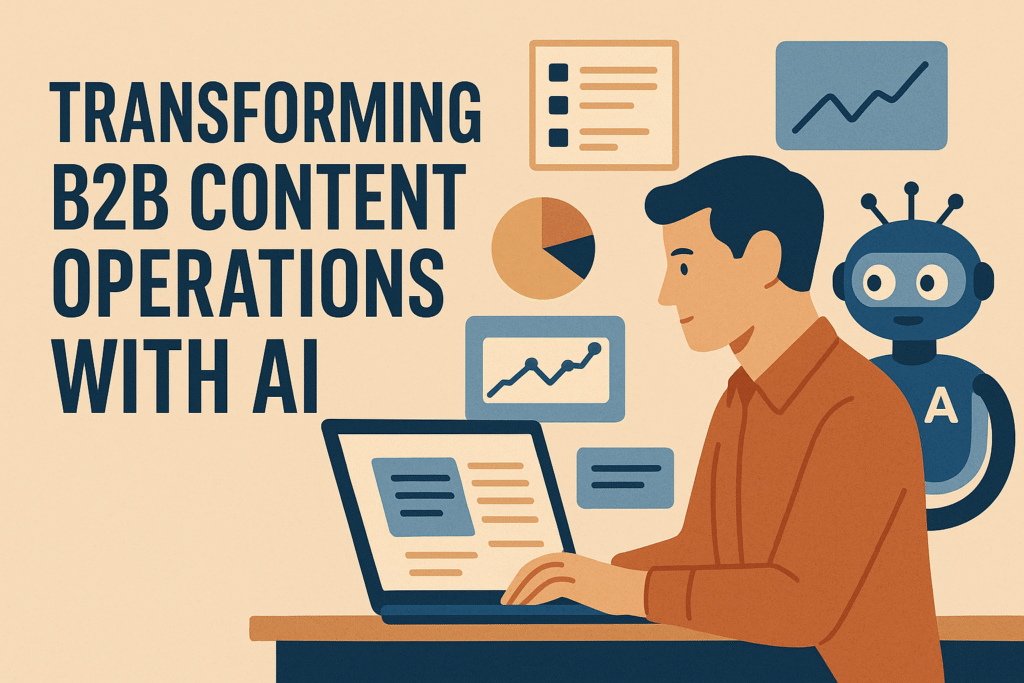The B2B content landscape has fundamentally shifted. What once required armies of analysts, hours of manual auditing, and gut-instinct planning can now be transformed through intelligent automation. Yet many content marketers are still stuck in spreadsheet purgatory, manually categorizing content and making strategic decisions based on incomplete data.
If you’re a content marketer, demand generation manager, or strategist feeling overwhelmed by the sheer volume of content decisions you need to make daily, AI isn’t just a nice-to-have anymore—it’s becoming essential for staying competitive. But here’s the thing: implementing AI effectively in your content operations isn’t about replacing human creativity. It’s about amplifying your strategic thinking and freeing up mental bandwidth for the work that truly matters.

The Current State of B2B Content Operations
Let’s be honest about where most B2B content teams stand today. You’re probably juggling content calendars across multiple platforms, trying to track performance metrics that live in different tools, and making educated guesses about what content will resonate with prospects at various funnel stages. Sound familiar?
The typical content audit process involves downloading data from various sources, manually categorizing hundreds of pieces of content, and spending weeks trying to identify patterns that should inform your strategy. Meanwhile, content planning often relies on a combination of keyword research, competitor analysis, and intuition—much of which could be systematized and enhanced through AI.
This manual approach isn’t just time-consuming; it’s limiting your ability to make data-driven decisions at the speed modern B2B marketing demands. When it takes three weeks to complete a content audit, the insights you uncover are already becoming stale.
Planning: From Gut Instinct to Data-Driven Strategy
Content planning with AI starts with understanding your audience’s content consumption patterns at a level of granularity that manual analysis simply can’t match. Modern AI content tools can analyze thousands of data points across your existing content, competitor content, and audience engagement patterns to surface insights that would take a human analyst months to identify.
The most effective approach begins with feeding your AI system comprehensive data about your current content performance. This includes not just pageviews and conversion rates, but engagement depth, content completion rates, and progression patterns through your funnel. LLM for marketing applications can then identify subtle patterns in what drives engagement for different audience segments.
For example, you might discover that technical decision-makers engage most deeply with case studies that include specific implementation details, while business stakeholders prefer high-level ROI-focused summaries. This kind of nuanced insight allows you to plan content that speaks to each audience segment in their preferred format and depth.
One particularly powerful planning application involves using AI to map content gaps across your buyer’s journey. By analyzing your existing content library against ideal customer journey stages, AI can identify exactly where prospects might be losing momentum due to missing content. This creates a prioritized content creation roadmap based on actual conversion impact rather than assumptions.
The key is training your AI system to understand your specific business context. Generic content recommendations rarely work in B2B environments where technical nuance and industry expertise matter significantly. Feed your AI comprehensive information about your ideal customer profiles, industry challenges, and competitive landscape to generate planning insights that actually align with your market reality.
Auditing: Beyond Basic Performance Metrics
Traditional content audits focus on surface-level metrics like traffic and basic engagement. AI-powered content audit automation can dig much deeper, analyzing content quality, topic coverage, competitive positioning, and optimization opportunities at scale.
Start by using AI to categorize your entire content library automatically. Instead of manually tagging hundreds of blog posts, whitepapers, and case studies, AI can analyze content themes, target audience, funnel stage, and content format in minutes rather than weeks. This creates a foundation for deeper analysis that would be impossible to achieve manually.
Content audit automation becomes particularly powerful when analyzing content performance relative to search intent and competitive landscape. AI can evaluate how well your content addresses specific buyer questions compared to competitor content, identifying opportunities to create more comprehensive or differentiated pieces.
One often-overlooked audit application involves analyzing content progression patterns. AI can track how prospects move through your content library, identifying which pieces effectively drive further engagement and which represent dead ends. This insight allows you to optimize internal linking, create more effective content series, and identify opportunities for content updates that improve conversion paths.
The technical depth of AI auditing can also reveal optimization opportunities that humans might miss. For instance, AI can analyze content structure, readability, and technical SEO factors across your entire library simultaneously, creating prioritized improvement recommendations based on likely impact.
Don’t overlook the power of sentiment and tone analysis in your audits. AI can evaluate whether your content maintains consistent brand voice, identify pieces that might be too technical or too basic for their intended audience, and suggest tone adjustments that better align with buyer preferences at different journey stages.
Optimization: Continuous Improvement at Scale
Content optimization traditionally happens in reactive cycles—you notice declining performance, investigate manually, and make adjustments. AI enables proactive, continuous optimization that identifies and addresses performance issues before they significantly impact results.
Real-time performance monitoring through AI can flag content pieces that are underperforming relative to expectations, suggest specific optimization tactics, and even draft improved versions for your review. This shifts optimization from periodic overhauls to ongoing refinement.
The most sophisticated optimization applications involve dynamic content personalization based on visitor behavior and characteristics. While not every B2B organization needs enterprise-level personalization, even basic AI-driven content recommendations can significantly improve engagement and conversion rates.
Consider implementing AI tools that analyze user behavior patterns to suggest content improvements. If visitors consistently drop off at specific points in your longer-form content, AI can suggest structural changes, identify sections that need clarification, or recommend breaking complex pieces into more digestible formats.
Cross-channel optimization represents another frontier where AI excels. Instead of optimizing blog posts, email content, and social media posts in isolation, AI can identify messaging and positioning approaches that work effectively across multiple channels, ensuring consistent optimization efforts rather than conflicting tactics.
Practical Implementation: Getting Started Without Overwhelming Your Team
The biggest mistake content teams make when implementing AI is trying to transform everything simultaneously. Start with one specific use case where AI can deliver immediate value without disrupting existing workflows.
Content auditing often provides the best entry point because it delivers obvious time savings without requiring significant process changes. Choose one AI content audit tool and use it to analyze a subset of your content library. Focus on learning how to interpret the insights rather than trying to act on everything immediately.
As your team becomes comfortable with AI-generated insights, gradually expand into planning applications. Use AI to supplement rather than replace your existing planning process initially. Let the technology inform your human decision-making rather than automating decisions entirely.
Integration with existing tools matters more than you might expect. Choose AI solutions that work with your current content management systems, analytics platforms, and workflow tools. The goal is enhancing your current processes, not replacing your entire tech stack.
Measuring Success: KPIs That Matter for AI-Enhanced Content Operations
Traditional content KPIs remain important, but AI implementation requires additional metrics that measure process efficiency and decision quality. Track how AI insights influence content performance, but also measure time savings, decision confidence, and team capacity for strategic work.
Content planning efficiency can be measured through reduced time-to-publish for new content initiatives and improved accuracy in predicting content performance. Content audit efficiency shows up in faster identification of optimization opportunities and more comprehensive competitive analysis.
The ultimate success metric involves business impact: improved lead quality, shorter sales cycles, and better content ROI. However, these outcomes typically lag AI implementation by several months, so intermediate metrics around process improvement help demonstrate value while waiting for business results.
Looking Forward: The Evolution of AI in B2B Content
AI capabilities in content operations continue advancing rapidly. Natural language generation is improving to the point where AI can draft initial content versions that require minimal human editing. Predictive analytics are becoming sophisticated enough to forecast content performance before publication.
The teams that will thrive are those that view AI as a strategic multiplier rather than a replacement for human expertise. Your industry knowledge, audience understanding, and creative judgment remain irreplaceable. AI simply allows you to apply these strengths more efficiently and with better supporting data.
The future of B2B content isn’t about choosing between human creativity and AI efficiency—it’s about combining both to create content operations that are simultaneously more strategic and more scalable than either approach could achieve alone.
Start small, measure consistently, and focus on enhancing your team’s capabilities rather than replacing them. The content marketers who embrace this approach will find themselves with more time for strategic thinking, better data for decision-making, and significantly improved results across every content metric that matters.
